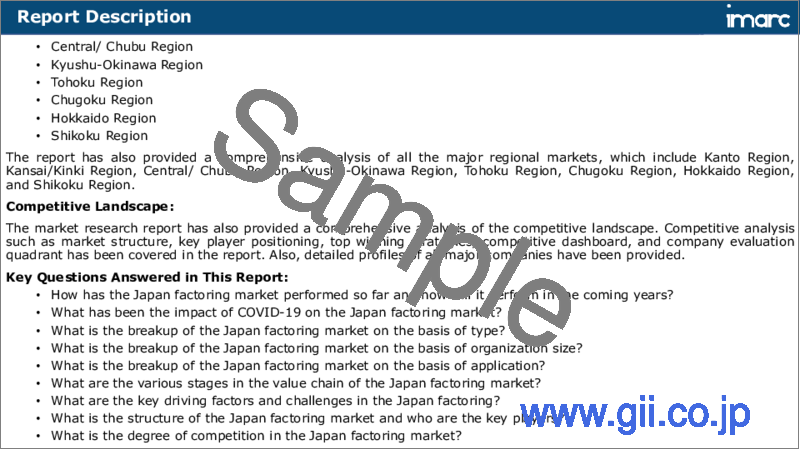|
|
市場調査レポート
商品コード
1746991
日本のファクタリング市場レポート:タイプ別、組織規模別、用途別、地域別、2025~2033年Japan Factoring Market Report by Type (International, Domestic), Organization Size (Small and Medium-sized Enterprises, Large Enterprises), Application (Transportation, Healthcare, Construction, Manufacturing, and Others), and Region 2025-2033 |
||||||
カスタマイズ可能
|
|||||||
| 日本のファクタリング市場レポート:タイプ別、組織規模別、用途別、地域別、2025~2033年 |
|
出版日: 2025年06月02日
発行: IMARC
ページ情報: 英文 122 Pages
納期: 5~7営業日
|
全表示
- 概要
- 目次
日本のファクタリング市場規模は2024年に1,835億米ドルに達しました。IMARC Groupは、2025年から2033年にかけての成長率(CAGR)は7.26%で、2033年には3,617億米ドルに達すると予測しています。非中核業務のアウトソーシングという新たな動向とともに、代替的な資金調達方法の人気が高まっていることが、主に市場成長の原動力となっています。
本レポートで扱う主な質問
- 日本のファクタリング市場はこれまでどのように推移し、今後どのように推移するのか?
- COVID-19が日本のファクタリング市場に与えた影響は?
- 日本のファクタリング市場のタイプ別区分は?
- 日本のファクタリング市場の組織規模別区分は?
- 日本のファクタリング市場の用途別区分は?
- 日本のファクタリング市場のバリューチェーンにおける様々なステージとは?
- 日本のファクタリングの主要な促進要因と課題は?
- 日本のファクタリング市場の構造と主要企業は?
- 日本のファクタリング市場における競合の程度は?
目次
第1章 序文
第2章 調査範囲と調査手法
- 調査の目的
- ステークホルダー
- データソース
- 市場推定
- 調査手法
第3章 エグゼクティブサマリー
第4章 日本のファクタリング市場-イントロダクション
- 概要
- 市場力学
- 業界動向
- 競合情報
第5章 日本のファクタリング市場情勢
- 過去および現在の市場動向(2019~2024年)
- 市場予測(2025~2033年)
第6章 日本のファクタリング市場- タイプ別の内訳
- 国外
- 国内
第7章 日本のファクタリング市場- 組織規模別の内訳
- 中小企業
- 大企業
第8章 日本のファクタリング市場- 用途別の内訳
- 交通機関
- ヘルスケア
- 建設
- 製造
- その他
第9章 日本のファクタリング市場-競合情勢
- 概要
- 市場構造
- 市場企業のポジショニング
- 主要成功戦略
- 競合ダッシュボード
- 企業評価象限
第10章 主要企業のプロファイル
第11章 日本のファクタリング市場- 業界分析
- 促進要因・抑制要因・機会
- ポーターのファイブフォース分析
- バリューチェーン分析
第12章 付録
Japan factoring market size reached USD 183.5 Billion in 2024. Looking forward, IMARC Group expects the market to reach USD 361.7 Billion by 2033, exhibiting a growth rate (CAGR) of 7.26% during 2025-2033. The inflating popularity of alternative financing methods, along with the emerging trend of outsourcing non-core activities, is primarily driving the market growth.
Factoring is a financial process in which a business sells its accounts receivable to a third party at a discounted rate. This transaction encompasses various types, including recourse, non-recourse, invoice, and reverse factoring. Factoring is widely utilized across diverse sectors such as manufacturing, retail, healthcare, logistics, technology, and construction. In addition to this, the benefits of factoring are manifold, ranging from providing immediate cash flow and simplifying accounting to reducing collection efforts, mitigating risk, improving the balance sheet, and facilitating scalability for businesses. Moreover, factoring also contributes to enhanced financial ratios, offers valuable credit risk analysis, and enables businesses to concentrate on their core activities.
Japan Factoring Market Trends:
The Japan factoring market is witnessing growth due to the increasing prevalence of financial instability and economic volatility, prompting businesses to embrace factoring as a means of attaining immediate liquidity. Moreover, the rising demand for factoring services is attributed to the prevalent trend of outsourcing non-core activities, including the management of accounts receivables, allowing companies to concentrate on their primary business operations. The market is further bolstered by the implementation of legal and regulatory support by various governments, recognizing and regulating factoring services. Apart from this, heightened awareness of alternative financing options, driven by financial literacy programs and digital media, is an additional factor contributing to the market's expansion. Additionally, the heightened competition among factoring companies is leading to more favorable terms, better interest rates, and bundled services, fostering market growth in Japan. Besides this, the increasing need for alternative financing approaches is a crucial driver propelling the expansion of the factoring market. Traditional financing avenues like bank loans or venture capital are accompanied by stringent eligibility standards, encompassing high credit scores, collateral mandates, and extensive documentation. This, in turn, is anticipated to fuel the market growth over the forecasted period.
Japan Factoring Market Segmentation:
Type Insights:
- International
- Domestic
Organization Size Insights:
- Small and Medium-sized Enterprises
- Large Enterprises
Application Insights:
- Transportation
- Healthcare
- Construction
- Manufacturing
- Others
Competitive Landscape:
The market research report has also provided a comprehensive analysis of the competitive landscape. Competitive analysis such as market structure, key player positioning, top winning strategies, competitive dashboard, and company evaluation quadrant has been covered in the report. Also, detailed profiles of all major companies have been provided.
Key Questions Answered in This Report:
- How has the Japan factoring market performed so far and how will it perform in the coming years?
- What has been the impact of COVID-19 on the Japan factoring market?
- What is the breakup of the Japan factoring market on the basis of type?
- What is the breakup of the Japan factoring market on the basis of organization size?
- What is the breakup of the Japan factoring market on the basis of application?
- What are the various stages in the value chain of the Japan factoring market?
- What are the key driving factors and challenges in the Japan factoring?
- What is the structure of the Japan factoring market and who are the key players?
- What is the degree of competition in the Japan factoring market?
Table of Contents
1 Preface
2 Scope and Methodology
- 2.1 Objectives of the Study
- 2.2 Stakeholders
- 2.3 Data Sources
- 2.3.1 Primary Sources
- 2.3.2 Secondary Sources
- 2.4 Market Estimation
- 2.4.1 Bottom-Up Approach
- 2.4.2 Top-Down Approach
- 2.5 Forecasting Methodology
3 Executive Summary
4 Japan Factoring Market - Introduction
- 4.1 Overview
- 4.2 Market Dynamics
- 4.3 Industry Trends
- 4.4 Competitive Intelligence
5 Japan Factoring Market Landscape
- 5.1 Historical and Current Market Trends (2019-2024)
- 5.2 Market Forecast (2025-2033)
6 Japan Factoring Market - Breakup by Type
- 6.1 International
- 6.1.1 Overview
- 6.1.2 Historical and Current Market Trends (2019-2024)
- 6.1.3 Market Forecast (2025-2033)
- 6.2 Domestic
- 6.2.1 Overview
- 6.2.2 Historical and Current Market Trends (2019-2024)
- 6.2.3 Market Forecast (2025-2033)
7 Japan Factoring Market - Breakup by Organization Size
- 7.1 Small and Medium-sized Enterprises
- 7.1.1 Overview
- 7.1.2 Historical and Current Market Trends (2019-2024)
- 7.1.3 Market Forecast (2025-2033)
- 7.2 Large Enterprises
- 7.2.1 Overview
- 7.2.2 Historical and Current Market Trends (2019-2024)
- 7.2.3 Market Forecast (2025-2033)
8 Japan Factoring Market - Breakup by Application
- 8.1 Transportation
- 8.1.1 Overview
- 8.1.2 Historical and Current Market Trends (2019-2024)
- 8.1.3 Market Forecast (2025-2033)
- 8.2 Healthcare
- 8.2.1 Overview
- 8.2.2 Historical and Current Market Trends (2019-2024)
- 8.2.3 Market Forecast (2025-2033)
- 8.3 Construction
- 8.3.1 Overview
- 8.3.2 Historical and Current Market Trends (2019-2024)
- 8.3.3 Market Forecast (2025-2033)
- 8.4 Manufacturing
- 8.4.1 Overview
- 8.4.2 Historical and Current Market Trends (2019-2024)
- 8.4.3 Market Forecast (2025-2033)
- 8.5 Others
- 8.5.1 Historical and Current Market Trends (2019-2024)
- 8.5.2 Market Forecast (2025-2033)
9 Japan Factoring Market - Competitive Landscape
- 9.1 Overview
- 9.2 Market Structure
- 9.3 Market Player Positioning
- 9.4 Top Winning Strategies
- 9.5 Competitive Dashboard
- 9.6 Company Evaluation Quadrant
10 Profiles of Key Players
- 10.1 Company A
- 10.1.1 Business Overview
- 10.1.2 Services Offered
- 10.1.3 Business Strategies
- 10.1.4 SWOT Analysis
- 10.1.5 Major News and Events
- 10.2 Company B
- 10.2.1 Business Overview
- 10.2.2 Services Offered
- 10.2.3 Business Strategies
- 10.2.4 SWOT Analysis
- 10.2.5 Major News and Events
- 10.3 Company C
- 10.3.1 Business Overview
- 10.3.2 Services Offered
- 10.3.3 Business Strategies
- 10.3.4 SWOT Analysis
- 10.3.5 Major News and Events
- 10.4 Company D
- 10.4.1 Business Overview
- 10.4.2 Services Offered
- 10.4.3 Business Strategies
- 10.4.4 SWOT Analysis
- 10.4.5 Major News and Events
- 10.5 Company E
- 10.5.1 Business Overview
- 10.5.2 Services Offered
- 10.5.3 Business Strategies
- 10.5.4 SWOT Analysis
- 10.5.5 Major News and Events
11 Japan Factoring Market - Industry Analysis
- 11.1 Drivers, Restraints, and Opportunities
- 11.1.1 Overview
- 11.1.2 Drivers
- 11.1.3 Restraints
- 11.1.4 Opportunities
- 11.2 Porters Five Forces Analysis
- 11.2.1 Overview
- 11.2.2 Bargaining Power of Buyers
- 11.2.3 Bargaining Power of Suppliers
- 11.2.4 Degree of Competition
- 11.2.5 Threat of New Entrants
- 11.2.6 Threat of Substitutes
- 11.3 Value Chain Analysis





